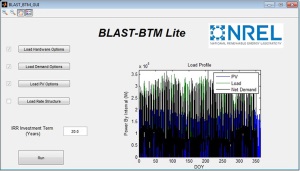by Brianna Crandall — March 13, 2015—The U.S. Department of Energy’s (DOE) National Renewable Energy Laboratory (NREL) has used the Battery Lifetime Analysis and Simulation Tool (BLAST) to confirm that energy storage for demand-charge management can deliver attractive economic benefits. The analysis paired recent utility rate structures with historic data on solar photovoltaic (PV) electricity generation and commercial facility loads to evaluate 6,860 unique scenarios. The results revealed that, in the absence of incentives, small battery systems reducing peak demand by 2.5 percent offer the most attractive return on investment.
 The free BLAST-BTM Lite tool download identifies cost-optimal energy storage solutions for behind-the-meter applications.
The free BLAST-BTM Lite tool download identifies cost-optimal energy storage solutions for behind-the-meter applications.(Click on image to enlarge)
Demand charges can account for more than 50 percent of a commercial customer’s monthly electric bill. Analysis conducted using the Behind-the-Meter (BTM-Lite) version of BLAST computed peak load reduction and electricity cost savings while also identifying energy storage system configurations that deliver the most favorable return on investment in the shortest time possible.
“Batteries for demand-charge reduction are most cost effective under today’s rate structures when configured for higher power-to-energy ratios, targeting discharge durations from 30 minutes to one hour,” NREL Energy Storage Task Leader Jeremy Neubauer said. “State or utility incentives are often necessary to make longer duration, lower power-to-energy ratio systems more attractive.”
The full suite of NREL-developed BLAST tools makes it possible to predict long-term performance of batteries and identify possible improvements in a wide range of applications, including in electric vehicles (BLAST-V) and stationary energy storage (BLAST-S). BLAST BTM-Lite is available for free download. It can also be paired with NREL’s Battery Ownership Model to assess lifetime battery costs in conjunction with performance, longevity, and new value propositions.
The full Deployment of Behind-The-Meter Energy Storage for Demand Charge Reduction report is available from the NREL Web site.




